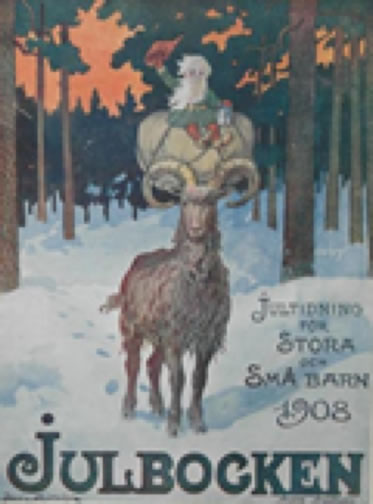Forget the Christmas turkey or ham. For many Japanese, traditional Christmas dinner is Kentucky Fried Chicken. Due to a combination of tiny Japanese ovens and a clever marketing campaign convincing locals that fried chicken is a traditional American Yuletide feast, reservations must be made to eat at a KFC on Christmas Day. During the run-up to Christmas, Colonel Sanders statues outside KFC’s Japanese outlets wear Santa gear. The chicken is served in special holiday packaging. Demand is such that an online service has been created: order your Xmas Family Bucket in advance and have it delivered.
In Norway, they have a solid idea of what witches and evil spirits do and do not like. And man, do those spirits love brooms. They also love Christmas, so on Christmas Eve, people hide their brooms, so witches and the like won’t hang around. For good measure, a male family member may pop his head out the front door and fire off a few blasts from a shotgun to show those spirits who’s boss.
The story goes that when German families decorate the Christmas tree, the last ornament to be hung is the Christmas pickle -usually a blown glass ornament that may have been passed down through generations. It is tucked away in a hard-to-see spot (it is green, after all). The first child who finds the pickle on Christmas morning gets a special gift and good luck all the next year.
Zwarte Piet, or Black Peter is Santa’s helper in the Netherlands. Sinterklass arrives on the eve of St. Nicholas Day in a steamship with his slave Zwarte Piet, portrayed in public processions in several cities. Since about 1850, children who don’t behave during the year were told that Black Peter might take them back to Spain, where Sinterklaas lives.
The racist aspects of the custom have been downplayed in recent decades, and the tale of Black Peter now describes him as a chimney sweep instead of a slave, which explains the blackface. But charges of racism still follow Black Peter, as he is often portrayed with an Afro and exaggerated features.
In certain parts of Scandinavia, nothing says “Merry Christmas” like a giant straw effigy of a goat.The “Yule Goat,” (or julbocken, if you’re fancy) originated like most Christmas traditions, in that people aren’t exactly sure. It has some roots in Norse mythology, wherein the god Thor rode around in a chariot pulled by goats. But in more recent history, the lore plays out more along the lines of the Christian association of goats as demonic creatures.
In the week leading up to Christmas, Venezuelans attend a daily church service called Misa de Aguinaldo (Early Morning Mass). In the capital, Caracas, it is customary to travel to the church service on roller skates. Indeed, so widespread is the practice, many roads in the capital are closed until 8am to provide Christmas worshippers with a safe passage.
In Austria, St Nicholas has an evil counterpart called Krampus. He is the bad cop to St Nick’s good cop, a demon-like creature with one task: to punish bad children before Christmas. Men dressed in devil costumes roam the streets, carrying chains and a basket for abducting especially bad children and hauling them to hell. It’s certainly one way to keep the kids off the streets.
Welcome to the bizarre Catalan tradition of caga tió or ‘defecating log’. Locals in Catalonia create a character out of a log, drawing a face on it and giving it a hat. Then they spend a fortnight ‘feeding’ it fruit, nuts and sweets. On Christmas Eve, the entire family beats the log with sticks and sings traditional songs until the log excretes all its treats. It’s hard to comprehend why this tradition hasn’t caught on elsewhere.
Next time you find yourself complaining about granny’s festive brussel sprouts, spare a thought for the poor tykes in Greenland. Each Christmas, they have to tuck into Mattak – raw whale skin with a little blubber – and kiviak, which is made by wrapping an auk (a small arctic bird) in seal skin, burying it for several months and eating its decomposed flesh
In Guatemala, cleanliness really is next to Godliness. Locals believe that the devil and other evil spirits live in the dark, dirty corners of your home.
Therefore, they spend the week before Christmas sweeping up, collecting rubbish and then piling everything in a huge heap outside. Finally, an effigy of the devil is placed on top and the whole thing is set on fire. It’s called La Quema del Diablo, the ‘Burning of the Devil’. The idea for Guatemalans is to burn all the bad from the previous year and start a new year from out of the ashes.

